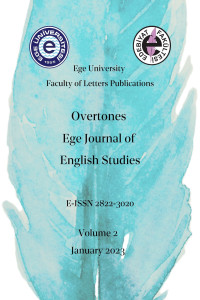Abstract
References
- Ahmed, Sara. The Cultural Politics of Emotion. New York: Routledge, 2004.
- Armstrong, Nancy. “Emily Brontë in and out of her Time”. Emily Brontë’s Wuthering Heights. Ed. Harold Bloom. New York: Infobase Publishing, 2007.
- Brennan, Teresa. The Transmission of Affect. Cornell University Press: Ithaca and London, 2004.
- Brontë, Emily. Wuthering Heights. Penguin Popular Classics: London, 1994.
- Van Ghent, Dorothy. “On Wuthering Heights”. Emily Brontë’s Wuthering Heights. Ed. Harold Bloom. New York: Infobase Publishing, 2007.
- Gilbert, Sandra M. and Susan Gubar. The Madwoman in the Attic: The Woman Writer and the Nineteenth-Century Literary Imagination. New Haven and London: Yale UP, 2000.
- Kermode, Frank. The Classic: Literary Images of Permanence and Change. Cambridge: Harvard University Press, 1983.
- Massumi, Brian. Parables for the Virtual: Movement, Affect, Sensation. Durham & London: Duke University Press, 2002.
- Miller, J. Hillis. “Wuthering Heights: Repetition and the ‘Uncanny’”. The Brontës. Ed. Harold Bloom. New York & Philedelphia: Chelsea House Publishers, 2005.
- Pykett, Lyn. Emily Brontë. Rowman & Littlefield Publishers, 1989.
- Seigworth, Gregory J. and Melissa Greg. “An Inventory of Shimmers”. The Affect Theory Reader. Durham & London: Duke University Press, 2010.
- Tytler, Graeme. "Nelly, I am Heathcliff!": The Problem of "Identification" in Wuthering Heights. The Midwest Quarterly; Winter 2006; 47, 2; p. 167.
Abstract
Although in the popular imagination Wuthering Heights evokes an aura of a gothic romance more than anything else, even a brief familiarity with the secondary literature makes it immediately evident that a confusion of boundaries and distinctions permeates Wuthering Heights on a formal, as well as a narrative and thematical level. In terms of genre, Wuthering Heights seems to occupy an ambiguous, liminal space; having generated a considerable amount of scholarly debate on whether it is a work of romance, or literary realism. Genre is important, as in settling this question, we also decide the manner in which we read the novel: which of its aspects to highlight and foreground, and which to assign a lesser degree of importance. Conventional literary criticism has mostly adopted an either/or approach to the question and then, often, argued for a conciliatory midpoint between the two alternatives, which are eventually discovered to be not so diametrically opposed, after all. I propose that instead of attempting to stabilize Wuthering Heights in order to subject it to this standard, supposedly dialectical hermeneutics, we acknowledge its movement and fluidity, and provide a coherent reading beginning from this grounding. I further argue that affect theory is a particularly useful instrument in reading Wuthering Heights, as it prioritizes movement and continuity rather than distinctions and categorizations, and I draw from scholars such as Sara Ahmed, Teresa Brennan, and Brian Massumi in order to demonstrate how affect theory might be brought to bear on a reading of the novel.
References
- Ahmed, Sara. The Cultural Politics of Emotion. New York: Routledge, 2004.
- Armstrong, Nancy. “Emily Brontë in and out of her Time”. Emily Brontë’s Wuthering Heights. Ed. Harold Bloom. New York: Infobase Publishing, 2007.
- Brennan, Teresa. The Transmission of Affect. Cornell University Press: Ithaca and London, 2004.
- Brontë, Emily. Wuthering Heights. Penguin Popular Classics: London, 1994.
- Van Ghent, Dorothy. “On Wuthering Heights”. Emily Brontë’s Wuthering Heights. Ed. Harold Bloom. New York: Infobase Publishing, 2007.
- Gilbert, Sandra M. and Susan Gubar. The Madwoman in the Attic: The Woman Writer and the Nineteenth-Century Literary Imagination. New Haven and London: Yale UP, 2000.
- Kermode, Frank. The Classic: Literary Images of Permanence and Change. Cambridge: Harvard University Press, 1983.
- Massumi, Brian. Parables for the Virtual: Movement, Affect, Sensation. Durham & London: Duke University Press, 2002.
- Miller, J. Hillis. “Wuthering Heights: Repetition and the ‘Uncanny’”. The Brontës. Ed. Harold Bloom. New York & Philedelphia: Chelsea House Publishers, 2005.
- Pykett, Lyn. Emily Brontë. Rowman & Littlefield Publishers, 1989.
- Seigworth, Gregory J. and Melissa Greg. “An Inventory of Shimmers”. The Affect Theory Reader. Durham & London: Duke University Press, 2010.
- Tytler, Graeme. "Nelly, I am Heathcliff!": The Problem of "Identification" in Wuthering Heights. The Midwest Quarterly; Winter 2006; 47, 2; p. 167.
Details
| Primary Language | English |
|---|---|
| Subjects | British and Irish Language, Literature and Culture |
| Journal Section | Research Articles |
| Authors | |
| Publication Date | January 23, 2023 |
| Submission Date | September 14, 2022 |
| Published in Issue | Year 2023 Issue: 2 |


